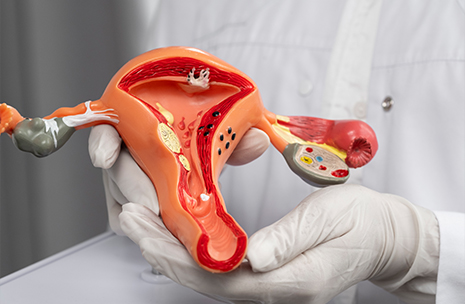
Uterine Fibroids
Uterine fibroid, a noncancerous growth of the uterus that often appear during childbearing age of female and also known as fibromyomas, leiomyomas or myomas; is one such gynecological disorder which is posing a major health problem. Less than 0.1% of all uterine fibroids are malignant. Regardless of benign neoplastic character, uterine fibroids are responsible for significant morbidity in a large segment of the female population.
Uterine fibroids are also called “myomas” or “leiomyomas”. These are benign tumors. Fibroids are formed when a single cell of smooth muscle present in the layer of uterus multiplies rapidly. Sometimes present in cervix. The formation and growth of fibroids is influenced by factor such as progesterone. Fibroids rarely appear before menarche mostly occurs during reproductive years of a female. It may vary in size, shape, position and number. Fibroids can be diagnosed by an ultrasound for its size and to follow its growth.
Types :
- Subserosal fibroids present in outer wall/layer of uterus (55%)
- Intramural fibroids present in muscular layer of uterus (40%)
- Submucosal fibroids are present in innermost layer which protrude into uterine cavity (5%)
Causes :
Exact cause is not known, but formation of fibroid may be related to disturbance in level of hormones progesterone and estrogen in females
Signs And Symptoms :
Mostly uterine fibroids are asymptomatic, often remain undiagnosed. Fibroids may cause chronic lower back pain, frequent miscarriage & sometimes infertility
Signs :
- Excessive uterine bleeding
- Problems related to pregnancy including infertility
- Repetitive loss of pregnancy
Symptoms :
Mostly women complains:
- Dull pain and discomfort in lower abdomen
- Heavy uterine bleeding
- Prolonged uterine bleeding
- Frequent/irregular periods
- Dyspareunia and non-cyclic pelvic pain
- Cramps during menstrual periods
- Weight gain
Some more symptoms seen in females
- Beginning signs of clotting.
- Lower back ache.
- Pain during sexual intercourse.
- Fullness of lower abdomen or abdomen size that of full term pregnancy.
- Frequent urination.
- Constipation.
- Miscarriage.
- Hair growth in chin areas along upper lip indicates thickening of the endometrium.
An Ayurvedic Approach :
Fibroids are mentioned under “granthi” or “arbuda”.
Pathogenesis of Granthi is propounded as when morbid Tridoshas, vitiate Rakta (blood), Mamsa (fleshy/muscles), and Meda (fat/adipose tissue) that are admixed with Kapha produce rounded protuberant, knotty or glandular and hard swelling called Granthi.
Granthi when present in yoni (female reproductive system)/Garbhashaya (uterus) will lead to disturbed menstrual cycle-menorrhagia, metrorrhagia, dysmenorrhea, etc., along with infertility.
According to Ayurveda the cyst and fibroid are formed due to accumulation of kapha dosha, along with disturbances in pitta and vata dosha. In Ayurveda artava vaha srotas comprises tissues, secretions and contents of uterus, ovaries, fallopian tubes, breasts and the channels which carry out female reproductive functions. If kapha dosha accumulation remains unchecked, these mass deposits can migrate to other parts of this system .The timing and coordination with psycho–biological cycles governs the Vata.
Kaphaja granthi are less painful and gradually increases in size. Pain and dark menstrual flow is there if accompanied with vata. Vitiation in pitta leads to heavy blood loss.
Treatment :
Vata, Kapha dominating Tridoshas are involved in the pathogenesis of the Granthi Roga hence Vata-Kaphahara medications are required, Dushyas are Rakta, Mamsa, and Meda hence the medications should possess Raktashodhaka (blood purifier), Lekhana (scrapping or dissolving) properties. Srotodushti is type of Sanga, Vimargagamana, Atipravritti so by Aamapachana and Vatanulomana drugs this problem can be controlled, and to combat Agnimandhya, medicines having Deepana (stomachic), Pachana (digestive) properties are required; with this hypothesis, Vata-Kaphahara (which alleviates vitiated Vata and Kapha Doshas), Raktashodhana (purification of blood), Lekhana (bio-scraping) and Shothahara (anti-inflammatory)

